There may be no greater concern in political science than the state of the job market. Particularly for newly minted Ph.D.s, the number and type of jobs available and their possibility of success on the market are sources of great anxiety. Similarly, department chairs, graduate directors, and dissertation chairs struggle as they make choices about recruiting faculty and students and determine how to advise their students as they progress toward their degrees. These concerns are common in most years, but they have been especially salient in the last several years, when the economic downturn has affected nearly every aspect of higher education. The purpose of this report is to present data that will assist faculty and students in navigating the political science employment landscape.
The report on the job market and placement in any given year is based on two datasets. One is the APSA e-Jobs market dataset, which includes all academic (and some nonacademic) advertisements made between June and May of each academic year for fall term starts. In this report, data from 2003–11 provide a longitudinal and cross-sectional perspective on the market. The other source of data is the APSA Graduate Placement Survey, which is administered in the fall to graduate directors, who provide information about those of their students who were on the market in the previous academic year. Because of the timing of the survey, these data are a year delayed. Thus, this report presents data about individuals in the placement class of 2009–10, who just finished their first year of employment. Next year, the report will focus on those individuals who were on the market during the academic year that has just ended.
SIGNS OF RECOVERY IN THE POLITICAL SCIENCE JOB MARKET
Table 1 presents the e-Jobs listings for the last nine years by the type of position advertised. It is encouraging to see that 2010–11 marks an 11% increase in the total number of listings from the previous year, a number nearly equal to the mean for the previous eight years. Even during 2009–10, which recorded the greatest dip in total jobs advertised in years, there were still more available positions than there were candidates on the market (as reported in the Placement Survey, see table 3). It appears that despite economic difficulties, political science has not experienced the severe supply and demand problem that other disciplines, such as history, have faced (Townsend Reference Townsend2010).
Table 1 Job Listings with e-Jobs, by Position Type, 2002–10
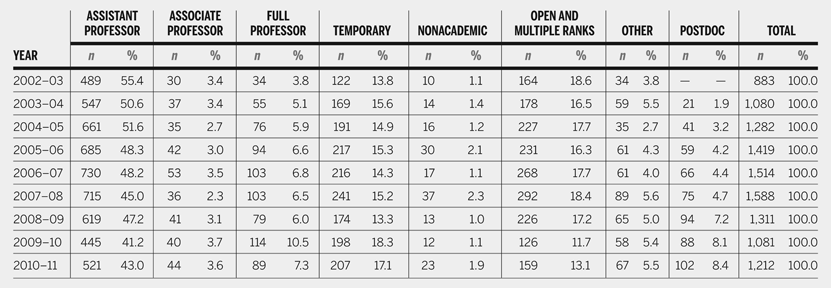
Among the several categories, we pay special attention to the assistant professor listings, as these positions speak most directly to the employment prospects of graduate students and junior faculty. Also, this permanent entry-level category is the most robust indicator of the health of the market, because departments are required to list all assistant professor positions in political science with e-Jobs (see American Political Science Association 2008). For these reasons, the rather precipitous drop in these positions in 2009–10 would be particularly worrying if it were not for the increases in both the total listings and listings for assistant professors (up 15%) in 2010–11.Footnote 1
It is worth noting that as a proportion of the total, the listings for assistant professor also increased over this time period. Indeed, as table 1 illustrates, the raw numbers may be misleading in terms of the timing and the possible causes of the decrease in these entry-level positions. While a sizeable reduction in these listings occurred from 2008–09 to 2009–10, a look back at the previous five years shows that a decline from 50% began before the current economic difficulties.
Another measure of the health of the discipline is the change in temporary (contingent) positions. Again, the raw numbers disguise an overall pattern of small ebbs and flows in ads for these positions as a proportion of the total listings for each year. Despite the notable increase in temporary positions in 2009–10, the decline in these positions in the latest market season is encouraging.
The listings that have experienced consistent growth over time are post doc positions, which appear to be filled disproportionately by international candidates, as indicated by the survey data presented in the next section.
Perhaps the most curious piece of jobs data concerns the increase in full professor listings in 2009–10, a time when listings for assistant professors were at their lowest and temporary positions at their highest points, presumably because money was tight. Part of this increase may be related to the need for full professors in administrative positions (36%), but full professors were also hired into academic positions.
Table 2 presents an overall picture of e-Jobs listings by academic and other fields. Generally, there are no surprises for the most commonly advertised fields. However, the change from the relative dominance of American politics over comparative and international relations (IR) early in the last decade to the ascendancy of IR in the most recent two years is striking. Interest in hiring in IR—and the decline in American politics listings—may have implications for the placement of different types of job candidates, as the survey data from 2009–10 suggest.
Table 2 Job Listings with e-Jobs, by Field, 2002–10

Of the 134 doctoral departments around the country that were surveyed, 68 (51%) reported data on a total of 501 students who were on the job market during the 2009–10 academic year (for a list of these departments, see appendix). The vast majority of these students were placed in an academic or nonacademic position within or related to political science (n = 436, or 87%). While larger doctoral programs (those with more than 20 faculty) responded at a higher rate than smaller programs, both are underrepresented among respondents. As in the past, we have weighted the data by department size, yielding 944 students on the market during 2009–10 and 816 (86%) who were placed in an academic or nonacademic position within or related to political science.
Candidate Characteristics
Table 3 presents characteristics of the 2009–10 placement class. Not surprisingly, most of the class was white and male. Still, the proportion of female candidates increased 2% over the previous year to nearly 40% of the class, comparable to the most recent data collected by the National Center for Education Statistics (NCES) on women earning doctorates in political science (39% in 2008–09; National Center for Education Statistics [NCES] 2010a). For some context, the same NCES report indicates that in 2008–09, women earned 45% of all social science doctorates, 59% of anthropology doctorates, 34% of economics doctorates, and 60% of sociology doctorates. Our own APSA Departmental Survey data show that 38% of doctorates in political science were earned by women in 2008–09.
Table 3 Characteristics of Job Market Candidates, 2009–10 (N = 944)
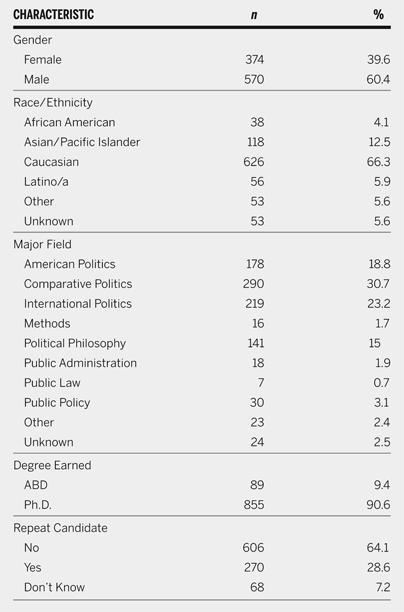
Among U.S. citizens (69% of candidates in 2009–10), the diversity distribution is largely unchanged from the previous year. Of the class, 81% was white, 5% African American, 4% Asian/Pacific Islander, and 4% Latino/a. The NCES does not report race and ethnicity data for specific disciplines within the social sciences (see NCES 2010b) but the National Science Foundation (2010) reports that 6% of U.S. citizens earning doctorates in political science were African American.
Many political science doctoral programs count international students as part of their student body. Nearly a third of the 2009–10 placement class were noncitizens or permanent residents (30%), up 4% from the previous year. While in the past Koreans were the dominant group of international students, Turkish and Chinese students each outnumbered Koreans nearly two to one in 2009–10, with Canadians and Indians close behind.
Most candidates studied comparative politics, followed by IR and American politics. In 2009–10, candidates with a major field in political philosophy rivaled those with a major field in American politics. It is worth noting that graduate directors did not classify 5% of their students, either because these individuals' research did not fit into one of the fields presented or because the directors did not know the candidate's major field.
The vast majority of this placement class entered the market with a doctorate in hand, but 9% pursued employment as ABDs. Two-thirds of the class was new to the job market, and just over a quarter were repeat candidates.
Placement Outcomes: Summary
In 2009–10, 816 graduate students found employment in political science–related academic and nonacademic jobs. Among this group, 396 (49%) were placed in permanent academic positions, 199 (24%) were placed in temporary positions, 151 (19%) took post docs, and 70 (9%) took political science–related positions outside academia. These data show interesting differences from the previous year: there was an 8% decline in permanent academic placements and a 5% decline in nonacademic placements, but an 8% increase in post docs.
There were also some notable changes from the previous year in the types of institution in which academic appointments were made. Among permanent academic positions, the distribution remained largely the same, with nearly half made in Ph.D.-granting departments, one-third offered in undergraduate degree departments, and roughly one-sixth offered in MA-granting departments. And, like before, less than 1% of permanent placements were in community colleges.
Differences emerge with placement in contingent positions. Whereas in the previous year, nearly half of these placements were made in BA-granting programs, in 2009–10, there was an even split in temporary placements between Ph.D.- and BA-granting programs (38% and 39%, respectively).
The placement data reveal that comparativists make up a greater proportion of permanent academic positions (31%) than do any other group, with this percentage rising from the previous year by several points. In contrast, the proportion of permanent IR positions dropped several points to 23%, and Americanists accounted for one-quarter of the placements, as they did the year before. Political philosophy remained unchanged at 10% of the permanent placements, while the remainder of positions were filled largely by candidates in public law, public administration, policy, and methods.
Among contingent positions, comparative, IR, and political philosophy were the dominant fields. While post docs have previously been heavily comparative, in 2009–10, these positions were held in nearly even proportions by comparativists and political philosophers.
A more nuanced picture of placement outcomes is presented in table 4 and will be the focus of the remainder of this report.
Table 4 Characteristics of Outcomes, 2009–10
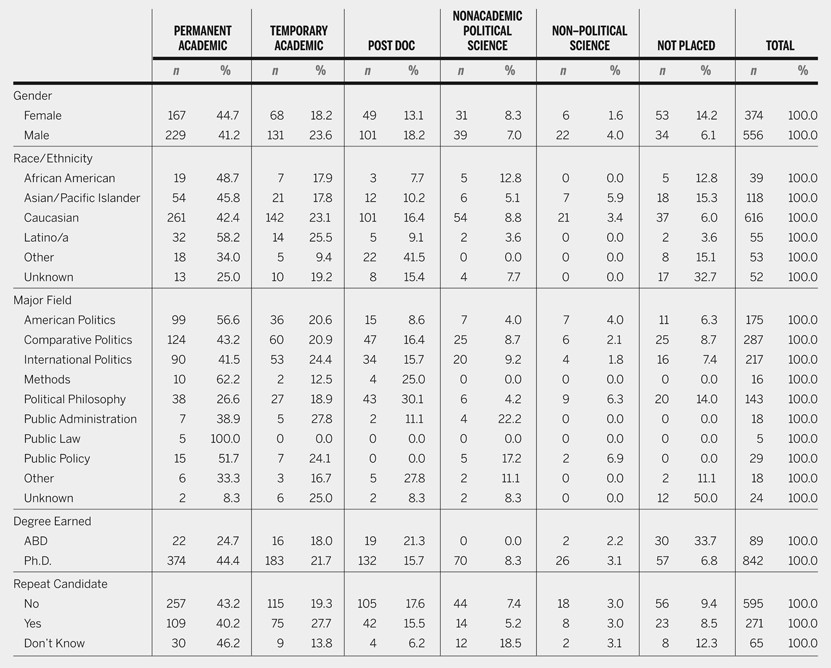
Placement Outcomes: Gender
Figure 1 illustrates the gender differences presented in table 3. As in the previous year, placement in permanent academic jobs was greater for women than men in 2009–10, although the difference was less this year than in previous years. Women are certainly keeping pace with men in competition for these highly desirable permanent positions.

Figure 1 Placement Outcome by Gender, 2009–10
However, a closer look at the data reveals that women were also placed in these positions as ABDs more often than were their male colleagues. The proportion of ABDs for each sex was lower in 2009–10 than in the year before, but women were placed without their degree nearly twice as often as men were (see figure 2).
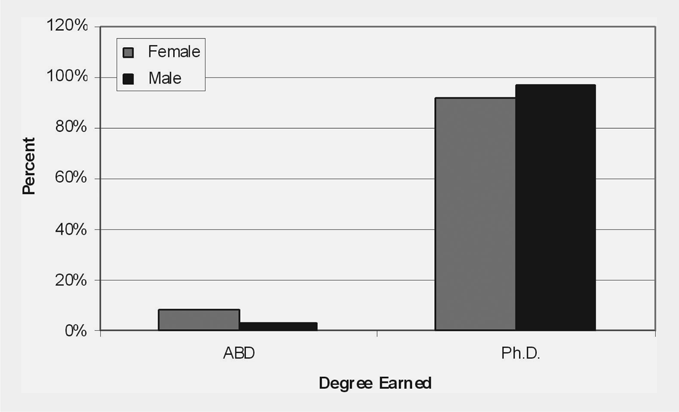
Figure 2 Permanent Academic Placement: Degree Earned by Gender, 2009–10
Furthermore, figure 3 illustrates that there may be some important differences between women and men regarding the type of academic institution by which they are employed. Most notably, a greater proportion of women than men took positions at institutions that offered BAs as their highest degree.

Figure 3 Permanent Academic Placement: Placement Level by Gender, 2009–10
This finding is perhaps surprising, given gender differences in field of study relative to the priorities of doctoral programs in 2009–10. More women than men were comparativists (35% and 28%, respectively), and twice as many men than women were Americanists (23% and 12%, respectively) in a job market in which doctoral programs made 60% of their hires in the comparative and IR fields, and only 15% in American politics. Still, BA programs hired Americanists and comparativists in nearly equal proportions (27% and 30%, respectively). Women had opportunities at both types of programs, but they were hired more often than their male counterparts by undergraduate programs. The data suggest that there may be more than research specialty at work in these placement differences.
Over 70% of job candidates of both sexes studied American, comparative, or international politics, but among the other fields of study, the data indicate that three times more men studied methods as their major field, and two times as many women studied public policy.
Placement Outcomes: Race and Ethnicity
Figure 4 illustrates clearly that Latino/as were the most successful job candidates in 2009–10, with nearly 60% placed in permanent academic positions and the lowest number of all groups going unemployed. This percentage marks an increase from the previous year in Latino/a gains in highly prized academic placements.
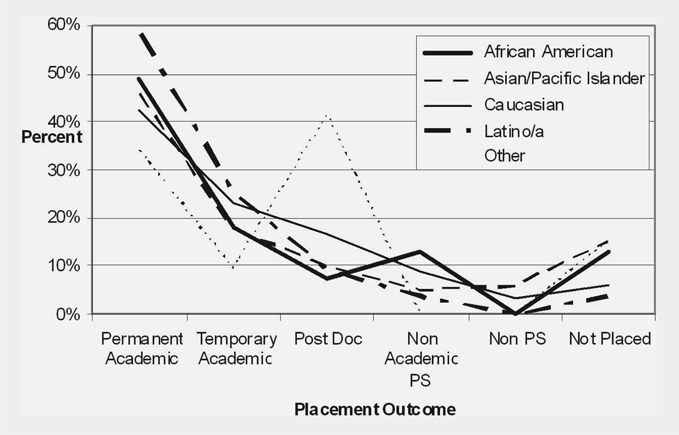
Figure 4 Placement Outcome by Race and Ethnicity, 2009–10
Perhaps the most notable change, however, is the decline among African Americans in permanent academic placements, from 65% of this group in 2008–09 to below 50% in 2009–10. These candidates were also placed least often in post doc positions and most often in nonacademic political science positions. While all other race and ethnic categories also declined in their proportion of permanent placements, the data show that greater proportions of white and Latino/a candidates landed temporary academic positions, and that whites earned post doc positions at a higher rate than any other group, except for international students (designated other).
As noted previously, 90% of job candidates went on the market after earning their PhDs; similarly, 94% of candidates placed in permanent academic positions had already earned their doctorate. But a closer look at these placements by race and ethnicity reveals that more black candidates—like women—were employed as ABDs than were any other group (see figure 5). Not a single Latino/a reported in this survey was placed as an ABD.
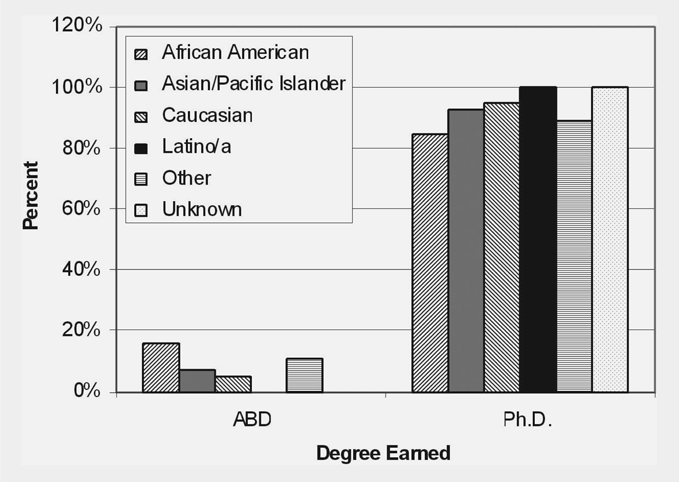
Figure 5 Permanent Academic Placements: Degree Earned by Race and Ethnicity, 2009–10
Moreover, blacks—again like women—who placed in permanent academic positions were hired significantly more often by BA-granting departments than were any other group and were hired least often of all groups by Ph.D.-granting programs (see figure 6). Unlike women, however, African Americans on the market included a high number of candidates studying American politics, and so area of research may play some role in explaining their employment in undergraduate programs.
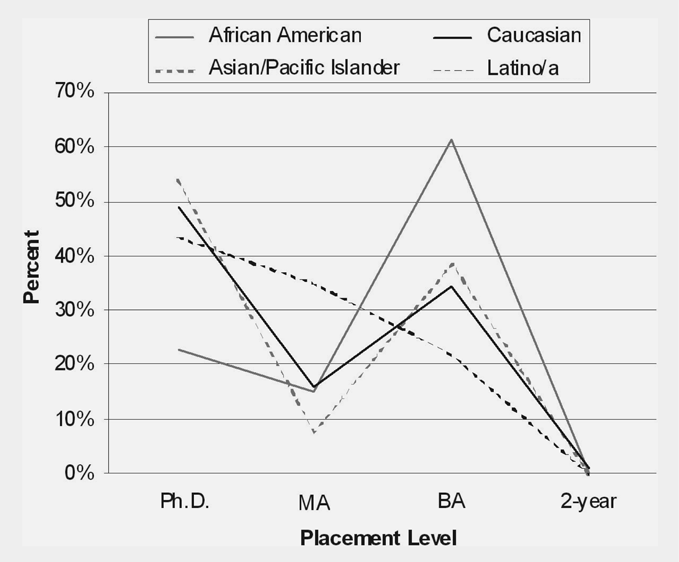
Figure 6 Permanent Academic Placements: Placement Level by Race and Ethnicity, 2009–10
Placement Outcomes: Women of Color
A final note on gender, race, and ethnicity concerns the data on women of color. All such women were placed with greater frequency than were white women. As discussed previously, Latino/as were very successful in earning permanent academic positions. But among women, this pattern is particularly evident; according to the survey data, every Latina on the market was placed in an academic position, and two-thirds were placed in permanent positions. African American women ranked second in terms of placement rate, with 53% placed in permanent positions. Among Asian and Pacific Islander women, 48% were placed in permanent positions, while 41% of white women secured these positions. African American women fared worst among women of color in the unemployed category, with 26% not placed, compared to 10% for Asian and Pacific Islander as well as white women and 0% for Latinas.
A closer look at placements for women of color reveals that more black women went on the market as ABDs (11%) than did Asian and Pacific Islander women (6%) and Latinas (0%); white women had the highest proportion of ABDs on the market (15%). Similarly, African American women were placed more often in BA-granting institutions (58.3%) and less often in Ph.D.-granting institutions (25%) than other women of color. More than half of the female Asian and Pacific Islander candidates landed at Ph.D.-granting institutions (55%), while 38% and 50% of Latinas were placed at Ph.D.- and MA-granting institutions, respectively. White women were evenly distributed between Ph.D.- and BA-granting institutions (42% and 43%, respectively).
Placement Outcomes: International Candidates
The role that foreign candidates play on the market is important for many reasons. In 2009–10, 38% of international candidates were largely placed in permanent academic positions; while down from the previous year, this proportion rivaled the 45% of U.S. citizens who landed these permanent positions. Most notably, fully 40% of the post doc positions were filled by international job candidates in a market that has seen a steady increase in the listings for these research positions over the last many years.
CONCLUDING THOUGHTS
The market in 2009–10 experienced some important declines in the number of available positions, particularly at the assistant level, but the signs of recovery in the most recent data are clear. It is also evident that there is notable variation in the success that job candidates experience on the market, particularly for historically underrepresented groups in political science. And with the evolution of different types of positions—such as post docs and contingent positions—it appears that the market and placement terrain of the political science landscape are changing. With subsequent placement surveys and improved tracking of listings through e-Jobs, the APSA will continue to monitor these developments so that departments, faculty, and students will be able to adapt to changing circumstances as they make choices about their futures.
APPENDIX: List of Graduate Program Respondents
-
American University
-
Arizona State University
-
Boston College
-
California Institute of Technology
-
Clark Atlanta University
-
Columbia University
-
Cornell University
-
Florida State University
-
George Washington University
-
Georgetown University
-
Georgia State University
-
Harvard University
-
Indiana University
-
Johns Hopkins University
-
Kent State University
-
Loyola university, Chicago
-
New School University
-
New York University
-
Northeastern University
-
Northern Illinois University
-
Northwestern University
-
Ohio State University
-
Pennsylvania State University
-
Princeton University
-
Purdue University
-
Stanford University
-
SUNY, Binghamton
-
SUNY, Stony Brook
-
SUNY, Albany
-
Temple University
-
University of Arizona
-
University of California, Los Angeles
-
University of Chicago
-
University of Cincinnati
-
University of Colorado, Boulder
-
University of Connecticut
-
University of Florida
-
University of Georgia
-
University of Houston
-
University of Illinois, Urbana Champaign
-
University of Iowa
-
University of Kansas
-
University of Maryland
-
University of Massachusetts, Amherst
-
University of Minnesota, Twin Cities
-
University of Missouri, Columbia
-
University of Missouri, ST. Louis
-
University of New Mexico
-
University of Notre Dame
-
University of Pennsylvania
-
University of Pittsburgh
-
University of Texas, Austin
-
University of Wisconsin, Madison
-
University of Wisconsin, Milwaukee
-
Vanderbilt University
-
Washington University, St. Louis
-
West Virginia University
-
Western Michigan University












